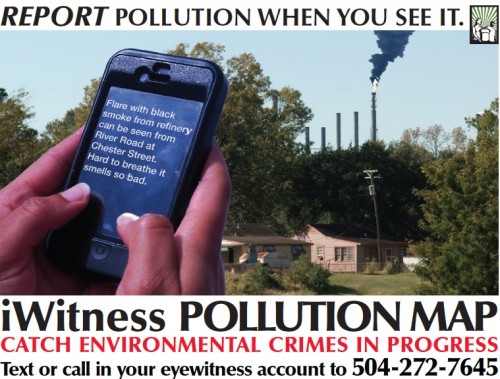[Guest post by Anna Hrybyk of the Louisiana Bucket Brigade. This ongoing environmental project started in May 2010 in response to the Gulf Oil Spill. Since that time, it continues to evolve environmental mapping. Anna Hrybyk has been working on public health issues since 1998. She is currently working as a Program Manager for the Refinery Efficiency Initiative.]
The
iWitness Pollution Map is produced by the
Louisiana Bucket Brigade (LABB). This map was created in 2010 so that fenceline communities, workers and concerned citizens can speak out about how petrochemical pollution is threatening your livelihood, your health and the ecosystems you rely on.
Currently the map hosts over 8,000 reports of petrochemical pollution across the Gulf Coast, including the BP Oil Disaster, the 31,0000 pound benzene spill by ExxonMobil Baton Rouge, and ten days of black smoke and flaring at Shell in Norco, Louisiana.

What is the iWitness Pollution Map?
This map visualizes reports of chemical accidents submitted via text message, phone calls, email and the web. Reports of oil spills, flaring, odors and health effects made by eyewitnesses and the media populate points on this interactive, web-based map. The information will be used to provide data about the impacts of industrial pollution in real time as well as document the stories of those who witness it.
Why does this map matter?
This map utilizes public testimony to visualize the impact of chemical accidents and the BP Oil Disaster over time and geography. By using information that comes from community members we will be able to track, document and make public the effects of industrial pollution. This will facilitate transparency, accountability and effectiveness in industry and government's response to chemical emergencies.
What happened to the Oil Spill Crisis Map?
It's still here! All the testimony and reports from the Oil Spill Crisis Map are archived on the new
iWitness Pollution Map. Anyone can still submit reports documenting effects of the BP Oil Disaster. Though unprecedented in its scale and impact, we recognize the BP Oil Disaster is part of a larger culture of accidents and spills that occur on a daily basis in the Gulf region. We wanted to create a tool to document ALL types of chemical accidents and the new name — iWitness Pollution Map — reflects this.
Who can use it?
Anyone who sees, smells or feels the impacts of chemical accidents and has access to a cell phone or computer can make a report. We are asking residents near industry and anyone else in impacted areas to assist us in getting people to make reports of what they are experiencing. The more reports submitted the more powerful each individual report becomes.
Connect with the iWitness team:
Help make our voice stronger by becoming an eMember!
Sign-up is simple and free just click here!
